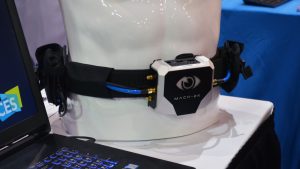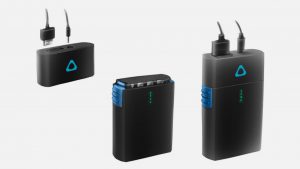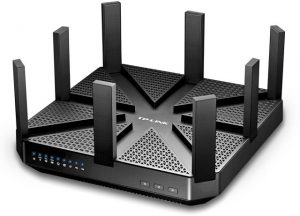Here are updates of the top seven companies perusing the ever elusive goal of providing wireless HMD transmissions.

IMR – Immersive Robotics (Mach-2K)
From IMR :
IMR is at the forefront of wireless Virtual Reality data streaming. Our proprietary algorithms and hardware architecture, produce UN-paralleled results.
At IMR we have a mission to create the world’s first compression standard for VR content. We are a technology company founded by leading aerospace, computer vision and robotics experts. We have developed an algorithm and hardware that enables Wireless transmission and streaming of VR video over 802.11ac Wi-Fi and 802.11ad WiGig standards. Transforming the VR industry and empowering a completely immersed and untethered experience for multiple players.
Immersive Robotics (IMR) has developed a new compression standard for VR content. The proprietary algorithm and electronics hardware enables wireless transmission and streaming of Virtual Reality (VR) video over 802.11ac Wi-Fi (5GHz) & the latest 802.11ad WiGig (60GHz) standards. The following is the description of its potency:
Rapid Data Transmission
With a 95{76c5cb8798b4dc9652375d1c19c86d53c1d1411f4e030dd406aa284e63c21817} compression rate, IMR’s technology allows for compression and decompression with a record breaking introduced latency of less than 1 ms. This translates to zero perceived latency by the player, increasing user comfort and the elimination of motion sickness caused by latency within VR play.
Image Quality
The quality of the decompressed image is indiscernible from the original with no motion blur or introduced artifacts.
Eye Tracking
IMR’s algorithm leverages a suite of highly “VR-optimized” techniques to reduce required bandwidth and operate at an extremely low latency. One option feature is an input for eye tracking data which allows for further dynamic control and greater compression efficiency.Versatile
IMR’s technology utilizes both the 802.11ac and 802.11ad wireless standards. This enables current generation HMDs to be supported via the AC standard, and future proofs the technology by enabling it to handle up to 2x 4K VR video transmission over the AD standard.Our technology is designed to operate across all VR and telepresence robotics applications and each has their own requirements for the wireless. Our technology provides the necessary compression/decompression at ultra low latencies for ALL these applications, and we are working with and looking to partner with different wireless manufacturers and communication link suppliers to push this technology into each area.
KwikVR
From QuickVR:
KwikVR’s unique advantage over other wireless competitors is hard to tell, because we have not been able to test our competitors’ solutions. They are all claiming an impossible one or two millisecond latency overhead, so I would say our main advantage is to be honest. Also, our solution does not use 60GHz Wi-fi at the top of the head of the user, which might be better for health reasons. Using 5GHz Wi-fi is also less prone to obstruction issues when it comes to the Wi-fi signal. We believe that our latency overhead is close to optimal, but only the customers will be the judges.

NGCodec
From NGCodec:
I think you can classify Wireless VR into what type of radio it uses and what type of compression. Of course all systems have to deliver under a frame of round trip latency.
Various Radio Types:
- WiFi 802.11ac 5GHHz & 2.4GHz
- WiFi 802.11ad 60GHz
- 5G LTE cellular for cloud VR (various frequencies)
- Proprietary radio in unlicensed frequency (e.g. 5GHz)
Our solution uses WiFi 802.11ac and LTE. This has the benefits of not needing line of sight transmission. 60GHz transmission suffers from large attenuation when propagating through physical barriers including humans. 802.11ac can travel much longer distance than 60GHz and provide multiple room coverage. 802.11ac is also much cheaper and requires much smaller wireless antennas than 60Ghz. Placement of the transmitter is not important with 802.11ac unlike 60GHz. 802.11ac is also lower power giving longer battery life of the HMD.
Various Compression Types
- JPEG (Intra frame) with 3:1 compression
- JPEG 2000 (Intra frame) with 6:1 compression
- MPEG H.264 (Intra and Inter frame) 100:1 compression
- MPEG H.265 (Intra and Inter frame) 200:1 compression
- Proprietary Compression
Our solution uses MPEG H.265/HEVC compression which provides 200:1 compression. E.g. a source of 1080p60 requires 3,000 Mbps to transmit uncompressed. We compress this to 15 Mbps a compression ratio of 200:1. This allows headroom for error correction and higher resolutions and frame rates as well as data rates that can be delivered from the cloud over 5G LTE and fibre networks. Standards based systems also allow off the shelf mobile chipsets to be used to build into mobile HMDs. We will adopt future H.265 profiles which can provide even better compression using tools like multi view and screen content coding tools.
Nitero
From Nitero:
While other vendors are focused on bringing wireless accessories to today’s HMDs, Nitero is the only company developing an integratable solution that will support the aggressive requirements of future VR HMDs.
The solution’s novel micro-second latency compression engine provides royalty-free, visually lossless encoding, adding end-to-end latency of one millisecond. At power below one Watt, it can be integrated into future headsets without the need for expensive heat sinks or vents. In fact, adding Nitero’s wireless solution will be significantly less expensive than cables, resulting in an overall cost reduction, which is critical for VR adoption going forward.
Interoperable with WiGig, Nitero has customized for the unique challenges in the VR/AR use cases with advanced beam-forming that supports NLOS at room-scale. Additionally, back-channel support for computer vision, eye-tracking, 3D-audio and other forthcoming technologies can be supported simultaneously with the VR display, without needing another chipset.
Some of the industry leaders that have supported Nitero via investment and collaboration include Valve Software, Super Ventures, and the Colopl VR Fund, along with others not publicly announced.
QuarkVR
From QuarkVR:
We use a combination of video compression and proprietary streaming protocol that allows us to stream high resolutions to multiple headsets. Our solution is designed primarily for Theme Parks and Arcades that want to put two or more people in the same tracked space.
Our thesis is that in the future you will always need some amount of compression, either when resolutions get higher (4K and above. We need 16K for retina resolution), or if you try to put the server outside the local network. Ideally, you could put a GPU farm in the cloud and have all the content available immediately thus even eliminating the need of a PC at home! I think that in five years the only computer you would need at home would be a small mobile chip, probably built into the headset itself.
Of course, any sort of compression introduces latency. However, there’s been a lot of development in the past two years to go around that. We’ll be releasing a network aware technology similar to Spacewarp that’s used by Oculus. And companies like Microsoft have done a lot of research on reducing latency by doing predictive (also known as speculative) rendering. Project Irides, for example, is able to compensate for 120 ms of network latency in their demo. We’ve been talking to one of the lead researchers of Irides for a while, and we’ll release similar technology in 2017. So I would say that the future of wireless VR is very bright!
HTC/Intel Aliance
WiGig (Intel’s chosen solution) is, as the name suggests, a wireless multi-gigabit networking standard which dramatically increases over-the-air bandwidth over standard WiFi over short distances (the same room). In actual fact, the name ‘WiGig’ is a shortening of the organisation (Wireless Gigabit Alliance) which helped define the IEEE 802.11ad 60GHz standard. WiGig is aimed at very high bandwidth data uses, such as the broadcast of multi-gigabit uncompressed video and audio streams. Although its uses are more limited (short range, doesn’t work well through walls) it is ultimately a very high speed general purpose network standard in the same way as other WiFi standards. Bottom line, if you buy an 802.11ad compatible router, it’ll not only be backwards compatible with your older devices, you’ll be able to use that extra bandwidth for any sort of data transfer, not just video and audio. WiGig data rates max out at 7 gigabits per second per channel.
TPCast
60GHz wireless technology is being investigated by a number of companies for use in wireless VR applications, including one that Valve invested in separately from HTC. While the frequency provides lots of bandwidth, it isn’t great at penetrating surfaces, meaning that it’s most effective when the transmitter has direct line-of-site to the receiver. The TPCAST wireless Vive kit has the transmitter mounted on the user’s head to give it a direct view to the receiver, but there’s certainly times during room-scale VR play where the user may be turned away from the receiver with their head tilted at an angle that would break line of sight; the player’s hands could also get in the way, though it isn’t clear yet how these situations might impact the TPCAST device’s performance, mostly because we don’t know the recommended setup for the system which could possibly use multiple receivers or recommend a special placement to prevent transmission issues.




